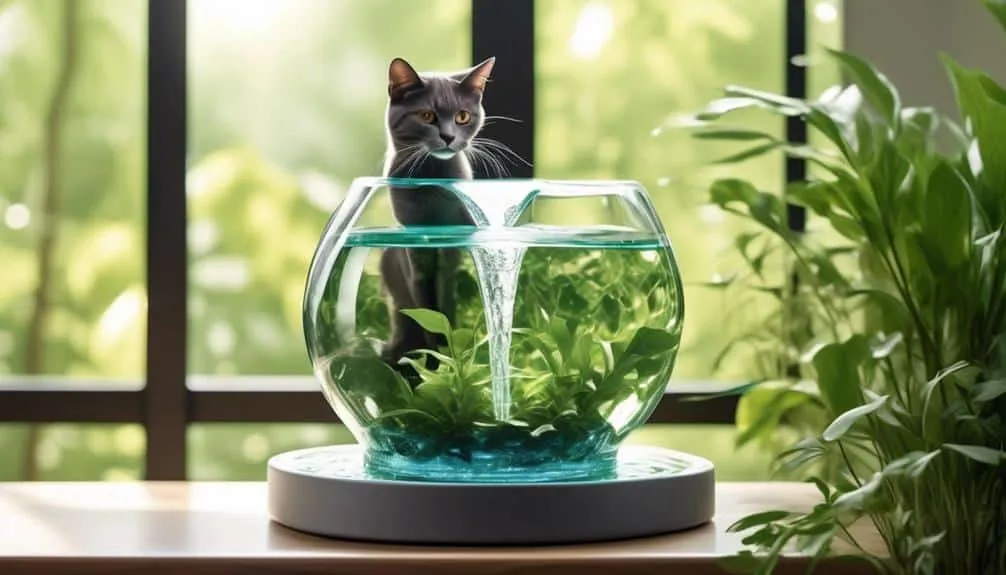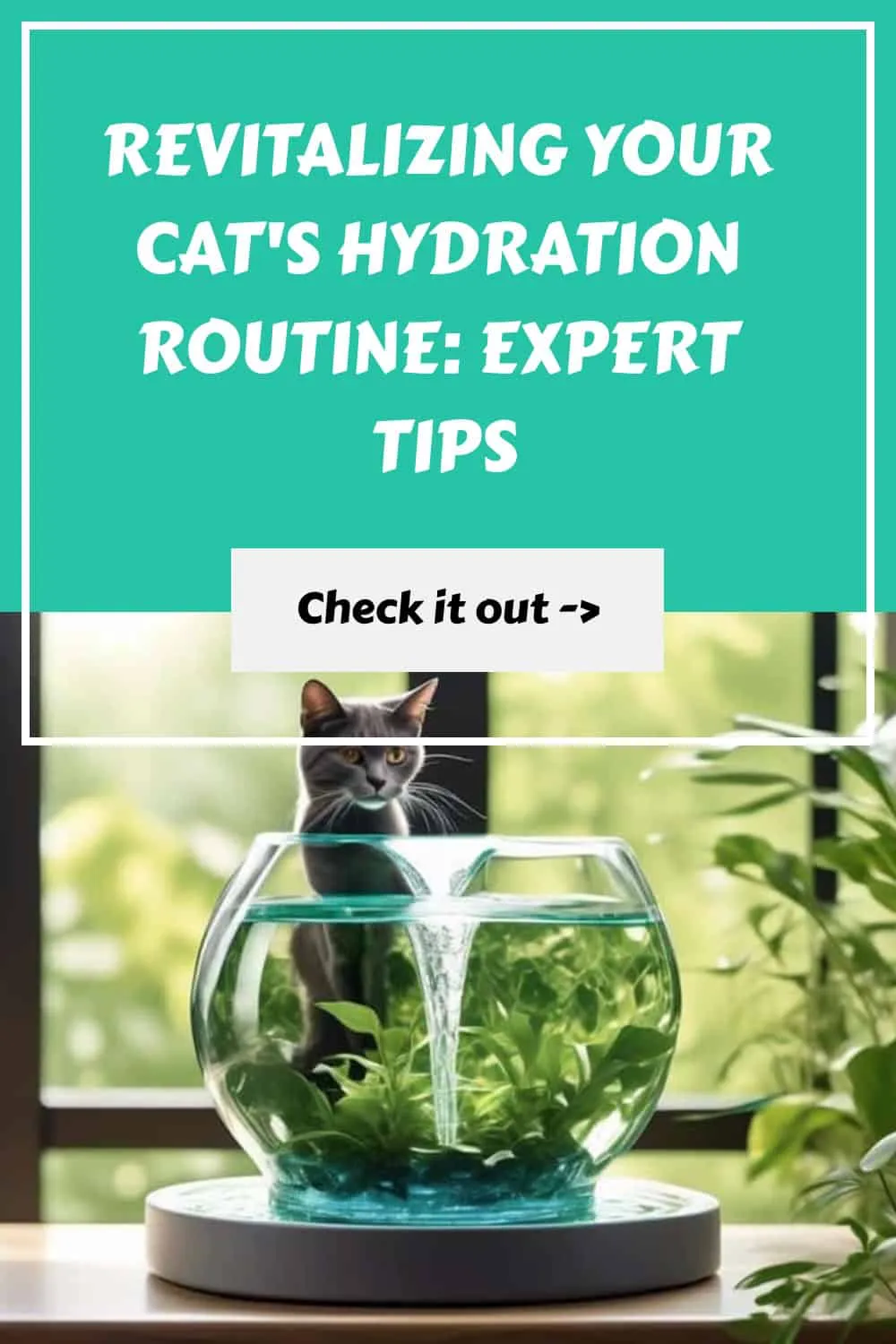The Best Fluffy Pancakes recipe you will fall in love with. Full of tips and tricks to help you make the best pancakes.

Proper hydration is essential for the health and well-being of your feline companion. However, ensuring that your cat gets enough water can sometimes be a challenge.
That's why in this article, we will delve into expert tips on revitalizing your cat's hydration routine. From understanding the importance of fresh water to exploring factors that can affect your cat's water consumption, we will provide you with valuable insights.
So, if you want to discover practical strategies to encourage your cat to drink more water, keep reading. Your cat's well-being may depend on it.
Key Takeaways
- Cats need access to fresh water at all times to maintain overall health.
- Factors such as age, size, activity level, and environmental conditions can affect a cat's water consumption.
- Monitoring water intake and providing multiple water sources can help promote hydration.
- Regularly changing and cleaning water bowls is important to ensure freshness and cleanliness.
Importance of Fresh Water for Cats
Fresh water is crucial for the overall health and well-being of cats. Adequate hydration is essential as it provides numerous benefits for cats. Water helps regulate body temperature, aids in digestion, and supports the proper functioning of various bodily systems.
Cats that do not consume enough water are at risk of dehydration, which can lead to serious health issues. Dehydration in cats can result in urinary tract problems, kidney disease, and even organ failure. It is therefore vital to provide cats with access to fresh water at all times to prevent these health risks.
Factors Affecting Water Consumption
Water consumption in cats is influenced by various factors that can impact their overall hydration levels. It is important for cat owners to monitor their feline's water intake to ensure they are adequately hydrated. Here are some key factors to consider:
- How to monitor water intake:
- Measure the amount of water you provide and note any changes in consumption.
- Observe your cat's behavior around water sources to see if they are drinking regularly.
- Consult with your veterinarian if you suspect your cat is not drinking enough water.
- The effect of stress on water consumption:
- Cats may drink less water when they are stressed or anxious.
- Changes in the environment, such as moving or introducing a new pet, can cause stress and affect water intake.
- Providing a calm and comfortable environment can help encourage your cat to drink more water.
Determining the Right Amount of Water
To ensure optimal hydration for your cat, it is crucial to determine the appropriate amount of water they need based on their body weight. Cats generally require 3.5 to 4.5 ounces of water per 5 pounds of body weight. However, the exact amount may vary depending on factors such as age, size, and activity level.
Monitoring hydration levels is essential in identifying any changes in a cat's health. Multiple water sources should be available throughout the house, and automatic water fountains can encourage cats to drink more.
To obtain specific guidance on your cat's water needs, it is recommended to consult with a veterinarian. They can provide personalized recommendations based on your cat's individual requirements, ensuring they receive the right amount of water to stay hydrated and healthy.
How Often to Change Cat's Water
To maintain optimal hygiene for your cat's hydration routine, it is important to establish a regular schedule for changing their water. Ensuring the frequency of water changes helps prevent bacterial growth and keeps your cat's water fresh and clean.
Here are some key points to consider:
- Daily water changes: Water should be changed daily to maintain freshness and cleanliness. Dirty water can harbor bacteria and contaminants that may compromise your cat's health.
- Regular cleaning: Regularly cleaning water bowls prevents the buildup of biofilm, which can lead to bacterial growth. Cats may refuse to drink stale or dirty water, so providing clean water encourages them to stay hydrated.
- Cat's preference: Cats have sensitive palates and may be more inclined to drink fresh water. By changing the water regularly, you can ensure that your cat always has access to clean and appealing hydration.
Tips for Encouraging Water Consumption
One effective method for increasing a cat's water consumption is by providing a variety of water bowl materials. Whisker friendly bowls can help prevent whisker stress, which occurs when a cat's sensitive whiskers touch the sides of a narrow bowl. Opting for wider and shallower bowls can alleviate this issue and encourage cats to drink more water.
Another option to consider is using a cat water fountain. These fountains provide running water, which some cats prefer over still water. The continuous flow of water in a fountain can attract cats and entice them to drink more. Additionally, cat water fountains offer benefits such as filtration, which helps maintain clean and fresh water, and oxygenation, which enhances the taste of the water.
Frequently Asked Questions
Can I Add Supplements or Vitamins to My Cat's Water to Improve Their Overall Health?
Supplementing a cat's water with vitamins can potentially improve their overall health. However, it is crucial to consult with a veterinarian before adding any supplements, as they can have specific dosage requirements and potential interactions with other medications.
Are There Any Signs or Symptoms That Indicate My Cat May Be Dehydrated?
Preventing dehydration in cats is crucial for their health. Signs of dehydration include lethargy, sunken eyes, and dry gums. Ensure your cat stays hydrated by providing fresh water, monitoring intake, and consulting a veterinarian for guidance on proper hydration.
Can I Use Filtered Water or Tap Water for My Cat, or Is Bottled Water Better?
Filtered water and tap water are generally safe for cats, as long as they meet quality standards. Bottled water may not provide any additional benefits. Proper hydration is crucial for cats' health, so ensuring access to clean, fresh water is key.
How Can I Encourage My Cat to Drink More Water if They Are Not Interested?
To encourage a cat to drink more water, provide multiple water sources throughout the house, use wide and shallow bowls, and consider using a fountain for running water. Adding ice cubes or flavorless broth can also make water more enticing.
Is It Normal for My Cat to Drink More Water During Certain Times of the Year?
It is normal for cats to drink more water during certain times of the year due to seasonal factors. Environmental changes like increased heat and humidity can lead to higher water consumption as cats try to stay hydrated.
Conclusion
In conclusion, ensuring that your cat stays properly hydrated is crucial for their overall health and well-being.
By understanding the importance of fresh water for cats, factors affecting water consumption, and how to determine the right amount of water, you can revitalize your cat's hydration routine.
Implementing expert tips such as regularly changing their water, providing multiple water sources, and using strategies to encourage water consumption can help maintain their optimal health.
Remember, a well-hydrated cat is a happy and healthy cat.










